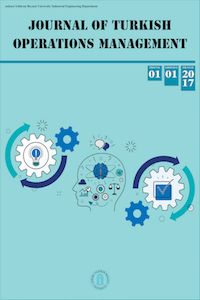Investigation of a Non-Linear Cramér-Lundberg Risk Model
Investigation of a Non-Linear Cramér-Lundberg Risk Model
Cramér-Lundberg risk model, Ruin probability Non-linear risk model, Lundberg type upper bound, Generalized Lundberg coefficient,
___
- [1] Asmussen, S., Rolski, T., (1994), “Risk Theory in a Periodic Environment: The Cramér-Lundberg Approximation and Lundberg's Inequality”, Mathematics of Operations Research, 19 (2), 410-433.
- [2] Boikov, A.V., (2002), “The Cramér-Lundberg model with stochastic premium process”, Theory of Probability and Applications, 47, 489-493.
- [3] Chadjiconstantinidis, S., Politis, K., (2007), "Two-sided bounds for the distribution of the deficit at ruin in the renewal risk model", Insurance: Mathematics and Economics, 41(1), 41-52.
- [4] Cohen, A., R.Young, V., (2020), “Rate of convergence of the probability of ruin in the Cramér-Lundberg model to its diffusion approximation”, Insurance: Mathematics and Economics, 93, 333-340.
- [5] Constantinescu, C., Samorodnitsky, G., Zhu, W., (2018), “Ruin probabilities in classical risk models with gamma claims”, Scandinavian Actuarial Journal, 2018(7), 555-575.
- [6] Cramér, H., (1930), “On the mathematical theory of risk”, Skandinavia Jubilee Volume, Stockholm. Reprinted in: martin-Löf, A. (Ed.) Cramér, H. (1994) Collected Works. Springer, 155-166.
- [7] Gaier, J., Grandits, P., Schachermayer, W., (2003), “Asymptotic Ruin Probabilities and Optimal Investment”, The Annals of Applied Probability, 13 (3), 1054-1076.
- [8] Gauchonab, R., Loisela, S., Rullièrea, J., Trufinc, J., (2020), “Optimal prevention strategies in the classical risk model”, Insurance: Mathematics and Economics, 91, 202-208.
- [9] Gerber, H.U. (1988), “Mathematical fun with ruin theory”, Insurance: Mathematics and Economics, 7(1), 15-23.
- [10] Kaas R., Goovaerts M., Dhaene J., Denuit M., (2001), “Modern Actuarial Risk Theory”, Kluwer, Boston.
- [11] Lundberg, F., (1903), “Approximerad framställning av sannolikhetsfunktionen”, Återförsäkring av kollektivrisker. Akad. Afhandling. Almqvist och Wiksell, Uppsala, 7-9.
- [12] Malinovskii, V.K, (2014), “Improved asymptotic upper bounds on the ruin capital in the Lundberg model of risk”, Insurance: Mathematics and Economics, 55, 301-309.
- [13] Mikosch, T. (2004), “Non-life insurance mathematics: An Introduction with Stochastic Processes”, Springer-Verlag, Berlin.
- [14] Mishura, Y., Perestyuk, M., Ragulina, O., (2014), “Ruin probability in a risk model with variable premium intensity and risky investments”, Opuscula Mathematica, 35(2).
- [15] Rolski, T., Schmidli, H., Schmidt, V., Teugels, J., (1999), “Stochastic Processes for Insurance and Finance”, Wiley, New York.
- [16] Straub E. (1988), “Non-Life Insurance Methematics”, Springer, New York.
- [17] Temnov, G., (2014), “Risk Models with Stochastic Premium and Ruin Probability Estimation”, Journal of Mathematical Sciences, 196, 84-96.
- [18] Willmot, G.E., Lin, X.S., (2001), “Lundberg Approximations for Compound Distributions with Insurance Applications”, Springer, Berlin.
- [19] Yang H. (1998), “Non-exponential Bounds for Ruin Probability with Interest Effect Included”, Scandinavian Actuarial Journal, 1999(1), 66-79.
- [20] Zhang, Z., Yang, H., (2009), “On a risk model with stochastic premiums income and dependence between income and loss”, Journal of Computational and Applied Mathematics, 234(1), 44-57.
- ISSN: 2630-6433
- Başlangıç: 2017
- Yayıncı: Ankara Yıldırım Beyazıt Üniversitesi
ORDER PICKER ROUTING PROBLEM IN A SINGLE BLOCK WAREHOUSE
Quality function deployment implementation on service sector
Dağıtık üretim içeren dağıtım şebekesi genişleme problemi için yeni bir matematiksel model
Ayşenur YURTSEVER, Berna DENGİZ, Burçin ÇAKIR, İsmail KARAOĞLAN
Novel last mile delivery models in terms of sustainable urban logistics
Şaban Fatih YILMAZ, Nadide AKTAŞ, Neslihan DEMİREL
Bir imalat firmasında en iyi ürün kalitesi için lazer ile kesim parametrelerinin en iyilenmesi
Mustafa YURDAKUL, Taha TÜKEL, Yusuf Tansel İÇ, İbrahim ÜLKE, Arif BALCI, Serkan GÜNEŞ
Performance Measurement in Cargo Distribution Center A Case Study
Geri Dönüşüm Atıklarının Toplanmasında Rota Optimizasyonu: Alanya İlçesinde Bir Uygulama
